Chapter
Nine
Money Growing on Trees: Forestry Surrounding the Wicomico
Aimee
Parker
While
taking a boat ride or canoeing along the Wicomico River, you can see forests
lining the banks. The tall
Loblolly Pine tower above the smaller hardwood trees such as Red Maple and
Sweet Gum.
[1]
It is hard for me to
imagine a time in which these forests were almost wiped out because of
deforestation. However, now on
the Eastern Shore, forest growth exceeds harvests.
[2]
The large increase in tree growth in recent years, while due in part to
various conservation efforts, is largely a result of tree farming.
Tree farms have become very important to not only Wicomico County’s
economy, but also the state’s economy.
While many people believe this farming may cause soil depletion and
creates an unnatural order to forests, tree farming in the end of the 20th
and the beginning of the 21st centuries has become much more
environment friendly.
Forestry
Use Before the 20th Century
Forests are very beneficial to
surrounding bodies of water. Deforestation
of stream banks has resulted in lower water quality of our rivers.
[3]
Forest buffers
(forests on either side of a body of water) are vital in maintaining clean
water in that they can help in controlling nonpoint source pollution.
[4]
These buffers not
only “shade streams to optimize light and temperature conditions for aquatic
plants and animals,” but also they remove excess sediments and nutrients
from shallow ground water and surface runoff.
[5]
Tree roots provide
protection by reducing shoreline erosion, thus adding stability to stream
banks.
[6]
The woody debris and
organic matter that result from surrounding stream bank forests also improve
living conditions for aquatic animals.
[7]
While the importance
of the forests to the waterways is easily recognizable, the importance of the
forests to people living on or near the Wicomico River has dramatically
changed over time.
The first clearing of forest lands surrounding the Wicomico River was
done by Indians who had been cutting firewood and burning the forests for
farming.
[8]
The Indians would
have been faced with predominantly hardwood forests, with a mixture of pine.
[9]
With the arrival of
European settlers also came a larger need for cleared land.
In the 1600s, all who dared to venture beyond the shore found
themselves engulfed with the surrounding wetlands and forests.
[10]
The English settlers
believed that in order to maximize economic development of the Chesapeake Bay
area, complete extermination of forests was necessary.
[11]
During the 17th
century, a large amount of deforestation occurred as a result of slash and
burn agriculture, which was primarily used to make way for tobacco fields.
[12]
On March 26, 1667,
men in Somerset County were ordered by direction of the county surveyor to
clear their own land to help make way for roads.
[13]
The forests that were
cut down were also used to send timber to England, Ireland, and the Caribbean.
[14]
The value of the
timber exportation industry in the Chesapeake area around the eve of the
American Revolution ranked third after tobacco and grain.
[15]
Although
forests were widely acclaimed as sources of fuel, timber, and money, the
American colonists saw them as obstacles to agriculture.
[16]
The lavish use of
wood by the American colonists can be seen in the use of worm fences.
[17]
These fences, which
were composed of six to ten rails at alternating angles, were used to protect
farm fields from wild animals.
[18]
One mile of fence
required 6,500 rails of timber.
[19]
During
the 18th century, slash and burn agriculture continued, although it
became difficult for landowners to acquire more land for tobacco farms.
[20]
Because of this, many
colonists migrated to forested areas to start a new life in the lumber
industry.
Near
the end of the 18th century, incorporation of sawmills increased
lumber exportation. Although the
exact date of the first sawmill used on the Wicomico River is uncertain,
the earliest mill may have been the Rockawalkin Mill, which began
operation in October of 1720.
[21]
The lumber
industry quickly increased in importance due to the large demand for the
native loblolly pine in Baltimore, Washington, D.C., Wilmington and
Philadelphia, and with the increase in demand came an increase in saw mills,
too.
[22]
This industry gave
the area its first economic boost, and changed the way forestry on the river
was viewed forever.
[23]
Forestry in the 20th and 21st
Centuries
During
the 1920’s and 30’s, people began to give up farming.
[24]
Because of this,
woodlands began to regrow. However,
during World War II, men were encouraged to cut their woodlands to help aid in
the war effort.
[25]
In 1943, it took
2,250,000 cords of pulpwood just to manufacture containers for shipping
supplies, food, and munitions overseas.
[26]
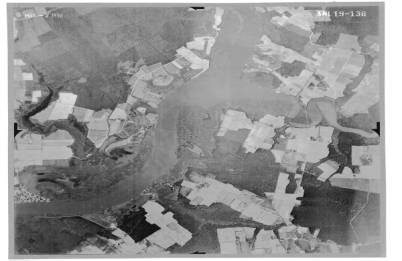
This is an aerial photograph of the Wicomico River taken on May 7, 1938. On the right where the Sicomico Creek Tributary forks off of the river is approximately where Redden Ferry Estates is located today.
Photo courtesy of Maryland DNR.
During the 50’s and 60’s, “high-grading” of forestland became a
large problem, resulting in growth of inferior trees.
[27]
High grading occurs
during selective harvesting when tree farmers take only the largest trees.
[28]
This was done to gain
maximum profit with minimal work.
[29]
For pine species,
which are intolerant to shade, this encourages the growth and overpopulation
of smaller, runt trees, which are unsuitable for lumbering purposes.
[30]
Eventually, a
decrease in high-grading occurred due to better market for hardwoods, new
harvesting techniques, and improvements in reforestation.
[31]
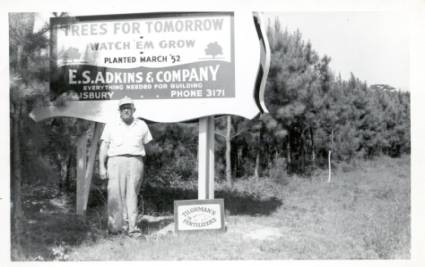
Here a man stands next to a recently planted loblolly tree farm.
Photo courtesy of the Nabb Research Center, from the
Tilghman Fertilizer Collection.
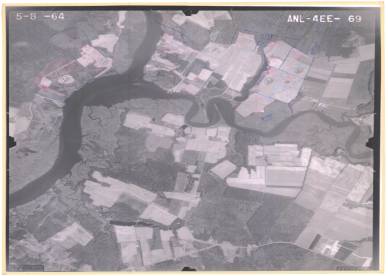
This is an aerial photograph taken on May 8, 1964, of a similar place on the river as the 1938 aerial photograph.
Photo courtesy of Maryland DNR.
During the 70’s and 80’s there was again a decrease in forests in
Wicomico County, which was due to the large increase in housing developments.
[32]
But with the coming
of the 90’s and the 21st century, again tree populations in
Wicomico County increased.

This aerial photograph was taken around 1983. Again, this is similar to the previous aerial photographs.
Photo courtesy of Maryland DNR.
Below
are cropped portions of the three previously shown aerial photographs.
Although exact calculations cannot be made, I believe that by looking
at the agricultural areas (generally white patches) on the photographs, you
can tell that these areas have remained almost exactly the same.
Although this is only a small portion of the river, to me, this shows
that forestry surrounding the Wicomico River has not declined substantially in
the twentieth century.
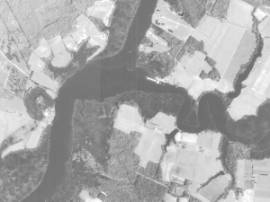
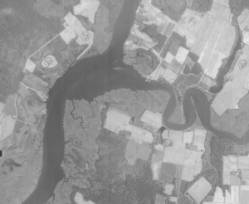
Aerial
photograph, May 7, 1938.
Aerial photograph,
May 8, 1964.
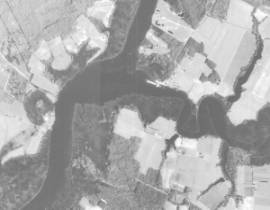
Aerial photograph, approximately 1983.
Photos courtesy of
Maryland DNR.
Although
there are no sawmills which operate on the Wicomico River today, several wood
processing plants still operate in Wicomico County such as Cropper Brothers,
J.V. Wells, and Glatfelter Industries. These
mills provide piling, poles, and timber.
[33]
Pulp is also made at
these plants.
[34]
This pulp is used
primarily for making paper and lumber.
[35]
There is also a mulch
plant in Pittsville that provides sawdust to chicken houses for flooring
purposes, and two wood treatment plants, Atlantic Wood Industries and Hebron
Long Life, all of which are located in Wicomico County.
Of
the 113,000 acres of woodland in Wicomico County a few years ago, greater than
80% is privately owned.
[36]
Loblolly pine, which
cannot be grown in latitudes North of the Eastern Shore, is still highly
sought after.
[37]
Pine is raised to
make shipping crates, veneer for furniture and shelving, building lumber,
chips for fuel and particleboard, and pulp for paper.
[38]
These trees are able
to grow quickly and can be harvested in about 40 years or less.
[39]
This yellow pine has
been referred to as “Southern Gold” because of its yield of approximately
$6,000 per acre, making the lumber industry the second largest industry on the
Eastern Shore of Maryland.
[40]
Tree Farming: A Closer Look
Tree farming is an organized form of growth and harvest of
timber. There are several methods
of harvesting, two of which are clear-cutting and selective harvesting.
In clear-cutting, all trees in an area are harvested at once, whereas
in selective harvesting, only mature trees are selected for harvesting, which
allows more room for younger trees.
[41]
Clear-cutting, while
aesthetically unpleasing, is the most efficient method for commercial logging.
[42]
It requires little
planning, few workers, and reaps the most trees for the greatest financial
gain.
[43]
“Selective logging,
on the other hand, requires a bigger area from which to harvest…[which]
means more roads, more workers, and more equipment in the forest.”
[44]
In Wicomico County, the softwood of the loblolly pine is most often
harvested by clear-cutting.
[45]
In general, the trees
are hand planted in 8 ft. by 8 ft. or 8 ft. by 10 ft. spacing.
[46]
During the first
thinning, which generally occurs around twenty years, small trees are
harvested for pulpwood.
[47]
Ideally, another
thinning will occur around thirty years in which small trees are again
harvested, but this time they will be used for pulp and small timber.
[48]
After about forty to
forty-five years, the pine trees will then be clear-cut, and the wood will be
used for saw timber.
[49]
While
many believe tree farming is bad for the ecosystem, loggers and foresters have
become much more conscientious of the impacts their business has on the
environment. The key to having an
environmentally friendly tree farm is to know where your sensitive lands are
located.
[50]
This enables the
farmer to minimize loose soil and lessen effects on water quality.
[51]
After speaking with
Steve Eccleston, the company forester of J.V. Wells, I learned that in his
nine years of working for J. V. Wells, a large difference that has occurred
has been better recovery of trees, resulting in less wasted lumber.
[52]
Also, in recent
years, more rules and regulations have been placed on the lumber industry.
[53]
By following these
guidelines set forth by various acts and programs, a healthier environment
will emerge.
Protecting Our Assets
In the latter years of the 20th Century, preservation has
become a primary concern for the government and citizens alike.
Since protests against logging on national forests have begun, annual
federal timber harvests have dropped in the last decade from around 13 billion
boardfeet to around 4 billion.
[54]
In Maryland alone,
many steps have been taken and are still being taken in order to conserve and
repair the environment. The
government has not only purchased land which is to be set aside, but it has
also implemented various acts and programs whose main goals are to beautify
and restore nature. Loggers and
foresters have also begun to make changes in their ways of farming and
harvesting which will be more beneficial to the environment.
A
Large Purchase
The Hancock Timber Resource Group (HTRG) is a forest investment firm,
which buys, sells and manages timberland.
[55]
In 1999, HTRG
purchased 278,000 acres of timberland from the Chesapeake Corporation, of
which 76,000 acres are on the Delmarva Peninsula.
[56]
Together with the
Conservation Fund, a nationally acclaimed land preservation organization, and
the Richard King Mellon Foundation, a conservation foundation which uses its
assets, totaling over $1.9 billion, to aid in national land and wildlife
conservation, the state of Maryland acquired 58,000 acres of land.
[57]
The Richard King
Mellon Foundation purchased 29,000 acres of land for $16.5 million, which it
donated to the state who matched this purchase.
[58]
Of these lands,
approximately 15,722 acres are located in Wicomico County.
[59]
While this land may
be used to protect wildlife and plant habitats or to support the timber
industry of the area, the public and all organizations who wish to be involved
will be allowed to have input into the management of the land.
[60]
Strides
Taken by the State
In the past fifteen years, the
state has enacted various acts and programs, which will help to conserve and
manage the forests surrounding the Wicomico River and the Chesapeake Bay.
In 1984, the Critical Area Act was passed, marking the first joint
venture against the negative impacts of development on wildlife and their
habitats by the state and local governments.
[61]
This law applied to
all waters of the Chesapeake Bay and its tributaries.
[62]
Because all lands
within 1,000 feet of the Mean High Water Line of tidal waters or the landward
edge of tidal wetlands and all waters of and lands under the Chesapeake Bay
and its tributaries, all forestland within this area would also be protected.
[63]
The
Forest Conservation Act was enacted in 1991.
[64]
This act was intended
to reduce the number of acres cleared when land is being developed.
[65]
Guidelines for the
amount of forestland that must be retained or planted after development are
categorized based on land use.
[66]
Categories of land
use are “agricultural and resource, medium-density residential,
institutional development, high-density residential, mixed use, planned-units
development, and commercial and industrial use areas.”
[67]
In
areas where there are little or no forests, planting of forests was required.
[68]
One of the first laws
of its kind in the nation, the Forest Conservation Act has already reduced the
degradation of forests.
[69]
Maryland
Stream ReLeaf is a program, which aims to conserve and restore forest buffers
throughout the state.
[70]
In 1996, Governor
Glendening pledged to create 600 miles of riparian forests by the year 2010.
[71]
Thus far the project
has been successful in noting that 208 miles of stream buffer were planted
between 1997 and 1999.
[72]
This will help
increase and protect new forest buffers.
The
Conservation Reserve Enhancement Program (CREP) was designed to help establish
forest buffers, restore wetlands, and retire highly erodible soils.
[73]
Both Governor
Glendening and Vice President Gore signed the Memorandum of Understanding
establishing the program.
[74]
The Governor hopes to
enroll 100,000 acres of land in the program as of the year 2002, which would
be rented from farms in the sensitive areas.
[75]
The program has not
been very successful thus far in noting that as of November 4, 2001, only
13,535 acres have been enrolled.
[76]
However, if this
program is continued, it is possible that more forest buffers will be planted
and protected.
The Future of Forestry
With European settlement came the destruction of the natural forests
surrounding the Wicomico River. However,
in the latter part of the 20th century, and in the earlier part of
the 21st century, steps have been taken in the right direction by the
government and foresters alike. With
the rules and regulations regarding forestry being set forth by the
government, and a broader knowledge of the effects of tree farming, forestry
in Wicomico County has a future which is certain to be brighter than its past.